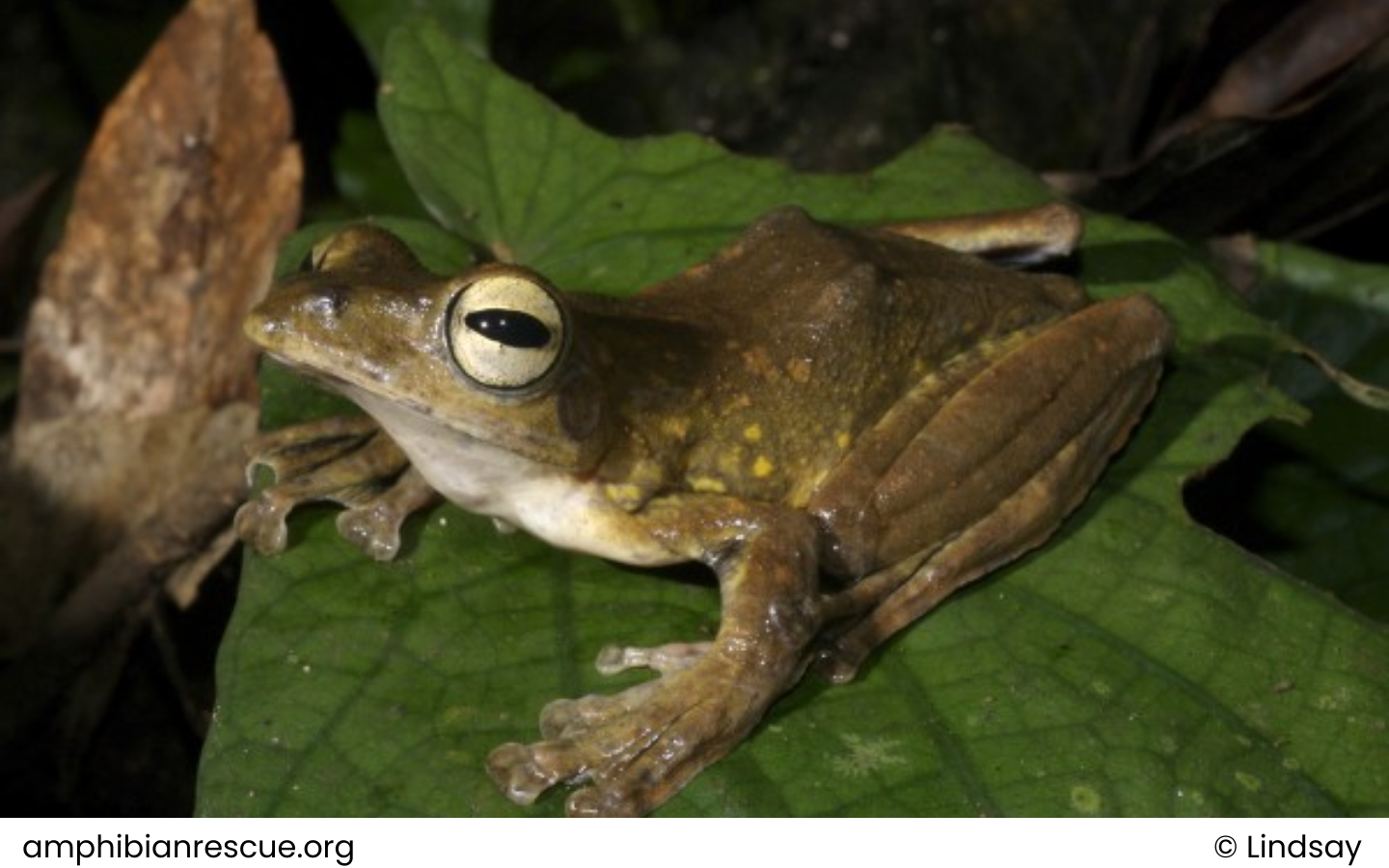
Science name: Rhacophorus annamensis – Smith, 1924
Taxonomic: Animalia>> Chordata>> Amphibia>> Anura >> Rhacophoridae >> annamensis
Species status: Endemic ; IUCN status: LC (Least Concern)
Description:
Physical Characteristics:
Rhacophorus annamensis is a large frog, with males reaching 72 mm in length and females up to 87 mm, though some individuals can grow as large as 110 mm. Its coloration varies between day and night, often displaying light to dark brown tones with yellow, red, or green markings. During the breeding season, these markings become more vivid, and the species exhibits striking coloration on its back, with bright hues on the belly such as yellow or pink. It has fully webbed limbs and large toe discs, which aid in its gliding ability, allowing it to leap distances of up to 1 meter between trees.
Distribution and habitat:
Altitude:
Rhacophorus annamensis is found at elevations ranging from 100 to 1,200 meters above sea level (asl).
Range:
This species is relatively widespread across central and southern Vietnam and extends into eastern Cambodia. It may also be present in parts of southern Laos, though this remains uncertain. The estimated extent of occurrence (EOO) is 336,160 km², and the species is recorded from six threat-defined locations. Further surveys may reveal a broader distribution in adjacent regions with similar habitats.
Habitat:
Rhacophorus annamensis is typically associated with evergreen forests and is most often found near pools, slow-moving streams, and flooded plains. It relies on forested wetlands for breeding, where it constructs foam nests on rocky surfaces or tree trunks near water sources. This frog is forest-dependent, and habitat disturbances such as deforestation are a concern in its range.
Behaviour and ecology:
Lifestyle:
This species is arboreal, commonly found on tree branches about 3–4 meters above the ground near streams in dense, shaded forests. Rhacophorus annamensis prefers habitats with abundant ferns, vines, and epiphytes, typically in areas with small streams and lush vegetation. Its diet consists of various insects found within its habitat.
Reproduction:
Breeding occurs between March and May, during which males follow females, and pairs are often seen mating. The species lays eggs in foam nests on branches, typically 2–10 meters above the ground. These nests can reach up to 9 cm in diameter. When the tadpoles hatch, rainwater carries them from the nests into nearby streams, where they develop further.
Conservation and status:
IUCN Red List Category and Criteria:
Rhacophorus annamensis is listed as “Least Concern” on the IUCN Red List, last assessed in 2015. Despite its decreasing population trend, the species is still relatively widespread and does not currently face the same level of risk as more restricted species.
Threats:
The main threat to Rhacophorus annamensis is habitat loss due to deforestation and land use changes, particularly in areas where evergreen forests are being cleared. Its dependence on forested streams for breeding makes it vulnerable to the impacts of habitat degradation.
Conservation Actions:
Although no specific conservation actions are in place for Rhacophorus annamensis, protecting the forested areas where it lives is essential. Forest conservation and habitat preservation efforts in Vietnam and Cambodia will likely benefit this species. It is also sometimes collected for the pet trade, so regulation of such activities is important to ensure its population remains stable in the wild.
Crocodile Trail – The Best Birding Trail in Cat Tien National Park
If you’re a birder or nature photographer planning a trip to Vietnam, few places offer [...]
Cong Troi Trail – Top 1 Dalat Plateau Birding Trail Experience
If you’re a birder or nature photographer planning a trip to Vietnam’s Central Highlands, the [...]
How to Identify the Greater Sand Plover, Tibetan Sand Plover and Siberian Sand Plover
Identification Differences within the Sand Plover Complex: The sand plover group, which was traditionally divided [...]
Highlights of Cat Tien National Park Reptiles and Amphibian Endemics
Spanning over 71,350 hectares of tropical forests, grasslands, and wetlands, Cat Tien National Park is [...]
Highlights of Cat Tien National Park Mammals in a World Biosphere Reserve
In addition to reptiles and birds, Cat Tien National Park is also rich in mammals, [...]
Kontum Plateau Endemic and Highlight bird
Kontum Plateau Endemic And Highlight Bird species like Chestnut-eared Laughingthrush and top birding routes while [...]